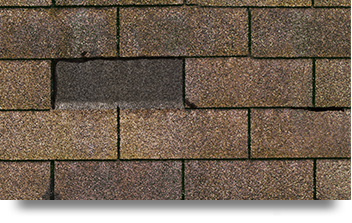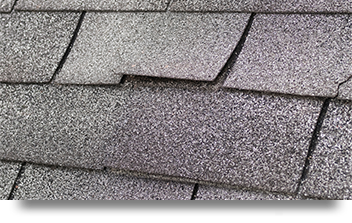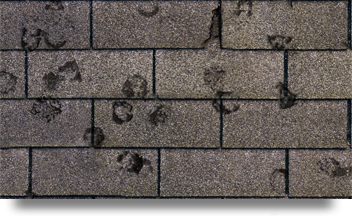Understanding Storm Damage
HomeUnderstanding Storm Damage
Spotting Potential Problems
Shingles are designed to protect against the weather, but the wind, rain and hail that often accompany a storm can cause damage. It’s also important to remember that not all storm damage is obvious and that hidden damage can cause problems weeks or even months after a storm.
Only a professional should climb up on your roof. Here are a few things you can look for from ground level:
To be sure you don’t have hidden damage, have your roof inspected by a contractor you can trust to provide an honest assessment.

High winds can tear and remove shingles, leaving the roof deck, underlayment or old shingles from a previous roof exposed to the elements.

Wind can also lift and curl shingles by breaking the seal that bonds them together, leaving your roof vulnerable to wind-driven rain.

Hail can leave dents or pockmarks in shingles, dislodging the protective granules that protect against rain and sun damage.
If your roof resembles any of the pictures you see here, there’s a good chance it needs to be replaced. Start with the Storm Damage Checklist below or get in touch with us before any further damage occurs.
Your Storm Damage Checklist
So you think you need a new roof. Don’t worry. This helpful guide will walk you through everything you need to know — and everything you need to do — to make your roof replacement go smoothly.
- Assess Your Roof for Storm Damage
Walk around the perimeter of your home and photograph or take note of any damage. Obvious signs of damage may include dented, torn curled or missing shingles.
- Check Gutters, Roofing Accessories and Windows
Though your shingles may appear undamaged, dents in gutters and roof vents may point to hidden roof damage. Also be sure to inspect windows for cracks, loose weatherstripping and torn screens.
- Inspect The Area Around Your Home
Check for fallen tree limbs, broken fences and damage to lawn furniture and exterior decorations. Look closely at flat surfaces such as patios and decks for signs of hail damage.
- Call a Contractor You Can Trust – Town & Country Roofing!
After a storm, there may be a lot of contractors competing for your attention. Regardless of who you decide to go with, make sure you choose a contractor you can trust — such as an Owens Corning™ Roofing Preferred or Platinum Preferred Contractor — to assess your damage, provide an estimate and replace your roof using proven products.
- Call a Contractor You Can Trust – Town & Country Roofing!
Refer to your notes, report a claim with your insurance company and arrange for an inspection.
NOTE: Do not attempt to climb up on your roof. Especially after a storm, the roof structure may be weakened and shingles may be slippery. If you suspect roof damage, call a professional contractor you can trust to assist you with your assessment.



